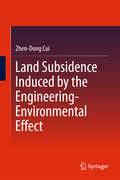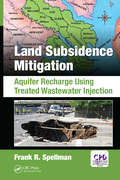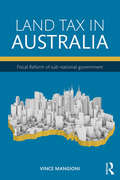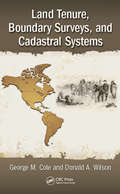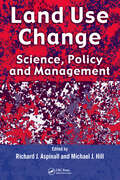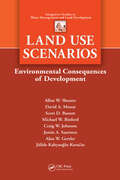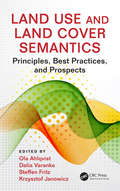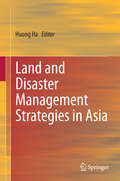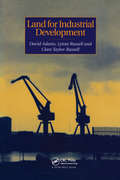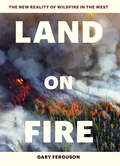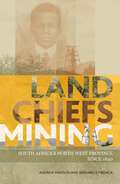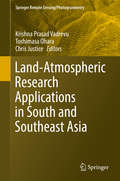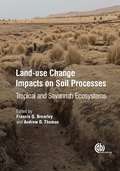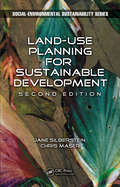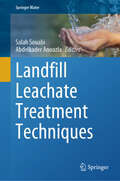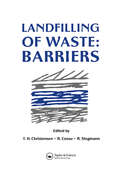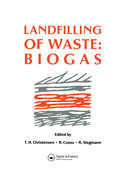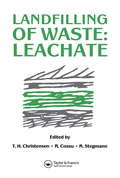- Table View
- List View
Land Subsidence Induced by the Engineering-Environmental Effect
by Zhen-Dong CuiThis book brings forward the concept of the geology-environmental capacity of ground buildings. It quantifies the geology-environmental capacity of ground buildings by analyzing the main factors of land subsidence and setting up the evaluation system. The geological environmental capacity of ground buildings is mainly controlled by the land subsidence and the output is the floor area ratio. According to the different geology structures and the different requirements of subsidence control in the soft soil areas in Shanghai, the evaluation system of the floor area ratio is built up by the adaptive neuro-fuzzy inference system (ANFIS) and the floor area ratios of four typical regions (Lujiazui, Xujiahui, Zhongyuan and Changqiao) are obtained by the ANFIS to offer references for urban planning. By taking the typical soft soil areas in Shanghai as case studies, this book will provide valuable insights to professors and graduate students in the field of Geotechnical Engineering, Civil Engineering, Engineering Geology and Environmental Geology.
Land Subsidence Mitigation: Aquifer Recharge Using Treated Wastewater Injection
by Frank R. SpellmanThis book examines the process of injecting treated wastewater into wells to replenish aquifers, and thereby slow the process of land subsidence, and help to mitigate coastal flooding. It explains how up to fifty percent of sea-level rise may be due to land subsidence, and up to fifty percent of land subsidence may be due to aquifer compaction. The concepts covered discuss replenishing aquifers with clean water to reduce nutrient discharges into out-falled waterways; providing a sustainable supply of groundwater; reducing the rate of land subsidence; and protecting the groundwater from saltwater intrusion. Practical case studies from Virginia and California will be included.
Land Tax in Australia: Fiscal reform of sub-national government
by Vince MangioniLand Tax in Australia demonstrates how land tax operates and is administered across State and local governments in Australia. International expert Vincent Mangioni reviews the current status and emerging trends in these taxes in Australia and compares them with the UK, USA, Canada, Denmark and New Zealand. Using substantial original research, the author sets out what Australia must do through practice and policy to reform and bring this tax into the 21st Century. <P><P>The need for fiscal reform and strengthening the finances of Australia’s sub-national government is long overdue. These reforms aim to minimise the taxpayer revolts encountered in previous attempts at land tax reform, while improving tax effort in line with other advanced OECD countries. <P><P>This book provides an essential resource for all property professionals working in development, valuation, law, investment, as well as accountants, tax economists and government administrators. It is highly recommended for students on property, taxation, legal and social science courses.
Land Tenure, Boundary Surveys, and Cadastral Systems
by Donald A. Wilson George M. ColeLand is important to all aspects of human life and has a key role in the economic well-being of society therefore, land tenure, land ownership, and real property law is a critical part of any developed nation. Together, the processes of how land parcels are held; how they are defined, measured, and described to allow economic transactions; how they are marked to allow their use and defense; and how they are legally protected have allowed for the orderly possession and use of land. In doing so, these processes have also provided the basis for the advanced economy of most developed nations. Very often, these processes—land tenure, boundary surveying, and cadastral systems—are considered separately. They are very much interrelated, and none of these processes may be completely understood without an understanding of the others. Land Tenure, Boundary Surveys, and Cadastral Systems provides an introduction to land tenure, cadastral systems, and boundary surveying, including an understanding of the interrelationship of these areas and their role in land tenure and real property law. This is especially true considering the advent of georeferenced cadastral maps reflecting the location of land parcels relative to many other components of the physical and legal infrastructure. Although intended as a basic text for college-level surveying courses, this book should also be of significant value to cadastral mappers, real property attorneys, land title professionals, and others involved with land transactions.
Land Use Change: Science, Policy and Management
by Michael J. Hill Richard J. AspinallChanges in the use of land reflect a variety of environmental and social factors, necessitating an equally varied suite of data to be used for effective analysis. While remote sensing, both from satellites and air photos, provides a central resource for study, socio-economic surveys, censuses, and map sources also supply a wealth of valid informati
Land Use Effects on Streamflow and Water Quality in the Northeastern United States
by Avril L. de la Cretaz Paul K. BartenFilling a long-standing need for a desk reference that synthesizes current research, Land Use Effects on Streamflow and Water Quality in the Northeastern United States reviews and discusses the impact of forest management, agriculture, and urbanization. The book provides a gateway to the diverse scientific literature that is urgently needed
Land Use Planning, Environmental Protection and Growth Management: The Florida Experience
by Robert A CatlinThis book examines the history and impact of Florida's Comprehensive Planning legislation. Topics include coastal zone management, solid waste planning, land use impacts, planning strategies, and more.
Land Use Scenarios: Environmental Consequences of Development (Integrative Studies in Water Management & Land Development)
by David A. Mouat Alan W. Shearer Scott D. Bassett Michael W. Binford Craig W. Johnson Justin A. Saarinen Alan W. Gertler Julide KoracinAny alteration of the natural processes occurring on a piece of land will have expected as well as unanticipated effects, and those effects have little regard for arbitrary human boundaries. Consequently, it is not enough for land managers to consider only how they might maintain the parcels for which they are responsible; they must also anticipate
Land Use and Land Cover Semantics: Principles, Best Practices, and Prospects
by Steffen Fritz Ola Ahlqvist Krzysztof Janowicz Dalia VarankaExplore the Important Role that the Semantics of Land Use and Land Cover Plays within a Broader Environmental ContextFocused on the information semantics of land use and land cover (LULC) and providing a platform for reassessing this field, Land Use and Land Cover Semantics: Principles, Best Practices, and Prospects presents a comprehensive overview of fundamental theories and best practices for applying semantics in LULC. Developed by a team of experts bridging relevant areas related to the subject (LULC studies, ontology, semantic uncertainty, information science, and earth observation), this book encourages effective and critical uses of LULC data and considers practical contexts where LULC semantics can play a vital role.The book includes work on conceptual and technological semantic practices, including but not limited to categorization; the definition of criteria for sets and their members; metadata; documentation for data reuse; ontology logic restrictions; reasoning from text sources; and explicit semantic specifications, ontologies, vocabularies, and design patterns. It also includes use cases from applicable semantics in searches, LULC classification, spatial analysis and visualization, issues of Big Data, knowledge infrastructures and their organization, and integration of bottom-up and top-down approaches to collaboration frameworks and interdisciplinary challenges such as EarthCube. This book: Centers on the link between planning goals, objectives, and policy and land use classification systems Uses examples of maps and databases to draw attention to the problems of semantic integration of land use/cover data Discusses the principles used in a categorization Explores the origins and impacts of semantic variation using the example of land cover Examines how crowd science and human perceptions can be used to improve the quality of land cover datasets, and more Land Use and Land Cover Semantics: Principles, Best Practices, and Prospects offers an up-to-date account of land use/land cover semantics, looks into aspects of semantic data modeling, and discusses current approaches, ongoing developments, and future trends. The book provides guidance to anyone working with land use or land cover data, looking to harmonize categories, repurpose data, or otherwise develop or use LULC datasets.
Land Use–Transport Interaction Models
by Rubén Cordera Ángel Ibeas Luigi dell’Olio Borja AlonsoTransport and the spatial location of population and activities have been important themes of study in engineering, social sciences and urban and regional planning for many decades. However, an integrated approach to the modelling of transport and land use has been rarely made, and common practice has been to model both phenomena independently. This book presents an introduction to the modelling of land use and transport interaction (LUTI), with a theoretical basis and a presentation of the broad state of the art. It also sets out the steps for building an operational LUTI model to provide a concrete application. The authors bring extensive experience in this cross-disciplinary field, primarily for an academic audience and for professionals seeking a thorough introduction.
Land and Disaster Management Strategies in Asia
by Huong HaThis book focuses on land and disaster governance in Asian countries. The Asian region has become increasingly vulnerable to natural disasters, including floods, cyclones, storms, earthquakes, drought, typhoons and tsunamis. Further, as a result of unsustainable changes being made in patterns of land use, catchment and coastal zones, increasing population density, migration patterns, and the spread of consumer culture across countries, the impact of natural disasters has increased manifold. The book addresses two major concerns in this field. Firstly, it discusses topics intended to raise awareness among all stakeholders of the critical aspects of disaster management in the context of Asia. Secondly, it calls upon policymakers, researchers, academics, practitioners, private enterprises and civil society organizations, as well as all those who have been, are and will be affected by natural disasters to search for innovative and novel approaches to reducing risk and managing disasters.
Land for Industrial Development
by D. Adams L. Russell C. Taylor-Russell Clare Taylor-RussellThis book provides a detailed account of the processes of land supply, land exchange and land development for manufacturing industry. It has a practical case-study based approach which provides an understanding of the motives and behaviour of critical factors in the development process.
Land on Fire: The New Reality of Wildfire in the West
by Gary FergusonWildfire season is burning longer and hotter, affecting more and more people, especially in the west. Land on Fire explores the fascinating science behind this phenomenon and the ongoing research to find a solution. This gripping narrative details how years of fire suppression and chronic drought have combined to make the situation so dire. Award-winning nature writer Gary Ferguson brings to life the extraordinary efforts of those responsible for fighting wildfires, and deftly explains how nature reacts in the aftermath of flames. Dramatic photographs reveal the terror and beauty of fire, as well as the staggering effect it has on the landscape.
Land, Chiefs, Mining: South Africa's North West Province since 1840
by Andrew Manson Bernard MbengaLand, Chiefs, Mining explores aspects of the experience of the Batswana in the thornveld and bushveld regions of the North-West Province, shedding light on defi ning issues, moments and individuals in this lesser known region of South Africa. Some of the focuses are: an important Tswana kgosi (chief ), Moiloa II of the Bahurutshe; responses to and participation in the South African War and its aftermath, 1899-1907; land acquisition; economic and political conditions in the reserves; resistance to Mangope’s Bophuthatswana; the impact of game parks and the Sun City resort; rural resistance and the liberation struggle; and African reaction to the platinum mining revolution. Written in a direct and accessible style, and illustrated with photographs and maps, the book provides an understanding, for a general reader ship, of the region and its recent history. At the same time it opens up avenues for further research. The authors, Andrew Manson and Bernard Mbenga, both based at North-West University, Mahikeng Campus, have, for some thirty years, been studying and writing on the region’s past.
Land-Atmospheric Research Applications in South and Southeast Asia (Springer Remote Sensing/photogrammetry Ser.)
by Krishna Prasad Vadrevu Toshimasa Ohara Chris JusticeThis edited volume sheds new light on the impact of rapid Land Use/Cover Changes (LU/CC) on greenhouse gases (GHG’s) and aerosol emissions in South and Southeast Asia. Several countries in South/Southeast Asia have the highest population growth rates in the world, which is the main cause for LU/CC. Conversion of dense forests to agricultural areas and then to residential and urban areas is most commonly observed in South/Southeast Asian countries with a significant release of GHG’s and aerosols. The book showcases several case studies on the use of remote sensing and geospatial technologies to quantify biomass burning and air pollution impacts, aerosol pollution, LU/CC, and impacts on ecosystem services. The book also includes articles on regional initiatives in research, capacity building, and training. The authors of this book are international experts in the field, and their contributions highlight significant drivers and impacts of air pollution in South/Southeast Asia. Readers will discover the latest tools and techniques, in particular, the use of satellite remote sensing and geospatial technologies for quantifying GHG’s, aerosols and pollution episodes in this region.
Land-Use Change Impacts on Soil Processes
by Andrew Thomas Subrata Ghoshal Chaudhuri Heather D’angelo Raghavan Dinesh Francis Brearley Caitlyn Gillikin Arkalgud Ganeshamurthy Krista Mcguire Dina MerrerThis book examines the effects that land-use changes (notably agricultural intensification, logging, soil erosion, urbanisation and mining) have on soil characteristics and processes in tropical and savannah environments. It covers a range of geographical regions and environments as impacts of land use change are often site specific. The effects of land use change on various aspects of the soil ecosystem from both a chemical and biological perspective will be examined.
Land-Use Change Impacts on Soil Processes: Tropical and Savannah Ecosystems
by Subrata Ghoshal Chaudhuri Raghavan Dinesh Caitlyn Gillikin Arkalgud Ganeshamurthy Dina Merrer Heather D’Angelo Krista McGuireThis book examines the effects that land-use changes (notably agricultural intensification, logging, soil erosion, urbanisation and mining) have on soil characteristics and processes in tropical and savannah environments. It covers a range of geographical regions and environments as impacts of land use change are often site specific. The effects of land use change on various aspects of the soil ecosystem from both a chemical and biological perspective will be examined.
Land-Use Modelling in Planning Practice
by Eric Koomen Judith Borsboom-van BeurdenThis book provides an overview of recent developments and applications of the Land Use Scanner model, which has been used in spatial planning for well over a decade. Internationally recognized as among the best of its kind, this versatile model can be applied at a national level for trend extrapolation, scenario studies and optimization, yet can also be employed in a smaller-scale regional context, as demonstrated by the assortment of regional case studies included in the book. Alongside these practical examples from the Netherlands, readers will find discussion of more theoretical aspects of land-use models as well as an assessment of various studies that aim to develop the Land-Use Scanner model further. Spanning the divide between the abstractions of land-use modelling and the imperatives of policy making, this is a cutting-edge account of the way in which the Land-Use Scanner approach is able to interrogate a spectrum of issues that range from climate change to transportation efficiency. Aimed at planners, researchers and policy makers who need to stay abreast of the latest advances in land-use modelling techniques in the context of planning practice, the book guides the reader through the applications supported by current instrumentation. It affords the opportunity for a wide readership to benefit from the extensive and acknowledged expertise of Dutch planners, who have originated a host of much-used models.
Land-Use Planning for Sustainable Development (Social Environmental Sustainability)
by Chris Maser Jane Silberstein M.A.Thirteen years ago, the first edition of Land-Use Planning for Sustainable Development examined the question: is the environmental doomsday scenario inevitable? It then presented the underlying concepts of sustainable land-use planning and an array of alternatives for modifying conventional planning for and regulation of the development of land. Th
Landfill Leachate Treatment Techniques (Springer Water)
by Salah Souabi Abdelkader AnouzlaThis book is a ready reckoner of recent information regarding the impact of leachate landfills, leachate treatment, and heavy metals on a single platform. The amount of waste is constantly growing due to population growth and the evolution of socioeconomic activities. Burying this waste produces leachate, a contaminated effluent created during the decomposition of organic waste and containing harmful substances like heavy metals, polyphenols, volatile organic compounds, and microorganisms. These effluents emit unpleasant odors associated with ammonium ions. These discharges significantly impact the environment. As a result, the master's and doctoral academics, researchers, and students will be able to comprehend the most recent developments in municipal solid waste landfill operations, supporting their research. This book inspires readers on how to deal with environmental pollution problems due to leachate contamination in freshwater and agricultural soils using a variety of technologies.
Landfilling of Waste: Barriers (Landfilling Of Waste Ser. #Vol. 2)
by T. H. ChristensenIn view of the great demand for information regarding landfills, a series of international reference books on landfilling of waste has been established. This book, the second volume, deals with lining and leachate collection. It consists of edited, selected contributions to the International Symposia on Sanitary Landfills held in Sardinia every second year.
Landfilling of Waste: Biogas
by T. H. ChristensenLandfilling of Waste: Biogas is the third in a series of reference books which provide a comprehensive overview of the state of the art and identify new directions in landfill technology and landfill research. As well as describing gas generation and composition, the book covers the environmental aspects, discusses gas production, extraction and transportation, treatment and utilization, emissions and safety, and ends with a selection of case studies.
Landfilling of Waste: Leachate
by T. H. Christensen R. Cossu R. StegmannLandfilling of waste has increased dramatically over recent years and there have been many examples of landfills which are unacceptable on environmental and health grounds. This is one of a group of international reference books which address this problem, specifically in this case covering the strongly contaminated wastewater developed from landfi
Landmarks
by Kai-Florian Richter Stephan WinterThis book covers the latest research on landmarks in GIS, including practical applications. It addresses perceptual and cognitive aspects of natural and artificial cognitive systems, computational aspects with respect to identifying or selecting landmarks for various purposes, and communication aspects of human-computer interaction for spatial information provision. Concise and organized, the book equips readers to handle complex conceptual aspects of trying to define and formally model these situations. The book provides a thorough review of the cognitive, conceptual, computational and communication aspects of GIS landmarks. This review is unique for comparing concepts across a spectrum of sub-disciplines in the field. Portions of the ideas discussed led to the world's first commercial navigation service using landmarks selected with cognitive principles. Landmarks: GI Science for Intelligent Services targets practitioners and researchers working in geographic information science, computer science, information science, cognitive science, geography and psychology. Advanced-level students in computer science, geography and psychology will also find this book valuable as a secondary textbook or reference.
Landmarks in Mapping: 50 Years of the Cartographic Journal
by Alexander Kent"Founded by the British Cartographic Society (BCS) and first published in June 1964, The Cartographic Journal was the first general distribution English language journal in cartography. This volume of classic papers and accompanying invited reflections brings together some of the key papers to celebrate 50 years of publication. It is a celebration of The Cartographic Journal and of the work that scholars, cartographers and map-makers have published which have made it the foremost international journal of cartography. The intention here is to bring a flavor of the breadth of the journal in one volume spanning the history to date. As a reference work it highlights some of the very best work and, perhaps, allows readers to discover or re-discover a paper from the annals. As we constantly strive for new work and new insights we mustn't ignore the vast repository of material that has gone before. It is this that has shaped cartography as it exists today and as new research contributes to the discipline, which will continue to do so."
